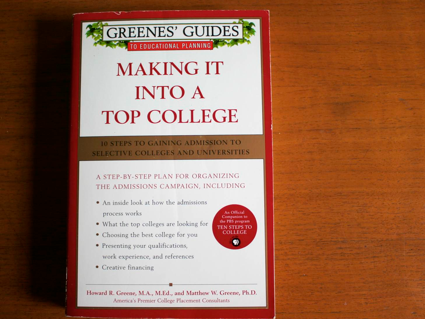Getting into a Top College: A Talk by Greene and Greene
0 Comments

I read the above book three years ago when my oldest daughter was applying to schools, and it was out of date then, published in 2000. Since that time, these authors have put out a whole slew of titles that you can see on the shelf in any teen section of the library. Written by the expensive (father & son) college consultants Greene and Greene, I jumped at the chance to hear them last night give a free talk at the library. I got an updated view of the landscape, and also got specific questions answered without having to pay for their expertise. Here is some of what I learned.
Getting into top colleges:
- 1% of applicants go to Ivy’s
- There are 3.3 million high school graduates (highest ever seen)
- 2/3 of those start college
- only 57% of those graduate in 6 years (with only a 29% graduation rate at public universities.) Graduation rates are so low colleges no longer report percentages of those who graduate in 4 years. These low numbers reflect that not enough kids are either ready for college or they are not finding the college that fits them best. (When kids cite the best and worst factors of their college experience, they all cite programs. The ones that went where there was a program that they wanted were happy, those that were unhappy did not have a good program fit. So look at programs and course offerings, and do not choose on the basis of reputation, selectivity, location, website design, spectator sports teams, etc)
- There are 10% more qualified girls so competition is stiffer among them.
- there are currently 19.1 million college students
- 1.5 million bachelor’s degrees given out annually
- 29% of 29 year old’s have a Bachelors (compared to 17% in 1971)
- Prices have gone way up, even for state funded schools
- AP is now the norm rather than the exception (so grade point is now compared on the 4.5 adjusted scale) but only 28% successfully pass an AP.
- Read the New York Times “The Choice” blog (click here)
- now much more pressure is coming from international students, who are actively pursued to take select spots in American schools.
- When Green (senior) worked as the Admissions officer for Princeton they had 5000 applications. At the writing of the above book in 2000 they had 14,875. Last year there were 35,000. All for the same 1,694 places.
- Because acceptance rates are so low, students have to apply more places to be sure to have a match. Admissions officers are unsure how many acceptances to offer because the desirable kids will be accepted in several schools, so extensive waiting lists are now the norm. Admissions offices also are filling up to 50% of their class with Early Decision applicants because it is a binding decision which simplifies their lives.
- Colleges like the high numbers of applications, and are marketing aggressively for it. They promote it because it improves their “selectivity rating.”
- On the other hand, colleges can’t read that many applications. Since they are submitted online now, they have widgets (little bots) that scan the applications for what they program it to look for. (AP’s, sports, geography or demographics, ethnicities, legacies, etc) Without any of the right buzz words, the application gets thrown out. Otherwise, your application gets placed in the segregated part of the pie you fall into. They offer first spots to kids that fit in more than one category of their predetermined “pie.” Other top contenders in any one slice are either accepted or wait-listed. More students are admitted based on statistics now than ever before.
- Your chance of having your application actually looked at improves greatly at schools with smaller applicant pools. This is particularly important for homeschoolers, where the rigor of curriculum has a wide variation.
- Most important factors for admission IN ORDER are: 1) Grades; 2) Test Scores; 3) Class Rank; 4) Recommendations; 5) Essay; 6) Extracurriculars; 7) Interview (i.e. don’t let your extracurriculars compromise your grades or your test prep! … Oops… As I write this my son has just left for the International Robotics tournament where he’ll compete this week – he’s not in class this week and next week are his big tests… God help him…)
- They talked extensively about the importance of the 5 P’s: Program, Performance, Preparation, Passion, and Presentation.
- Like a diversified investment portfolio, apply to diverse types of schools, for your best chance of a good return.
- Now every school will accept the ACT, some will even accept it in lieu of SAT Subject tests.
- News Flash! As of this year, you can pick and choose what SAT and SAT Subject tests you submit. Gone are the days where they automatically send them all.
- Students should graduate with no more than $24,000 in student loans…







